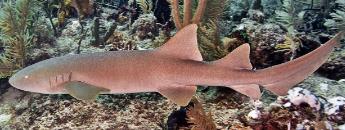
General:
Five to seven gill slits on the sides of the head, and pectoral fins that are not fused to the head. Sharks have a covering of dermal denticles that protects their skin from damage and parasites in addition to improving their fluid dynamics. They have numerous sets of replaceable teeth.
Five to seven gill slits on the sides of the head, and pectoral fins that are not fused to the head. Sharks have a covering of dermal denticles that protects their skin from damage and parasites in addition to improving their fluid dynamics. They have numerous sets of replaceable teeth.

GROUND SHARKS
Order: Carcharhiniformes
Order: Carcharhiniformes
CARPET SHARKS
Order: Orectolobiformes
Order: Orectolobiformes
Order: Carcharhiniformes
Characterized by the presence of a nictitating membrane over the eye, two dorsal fins, an anal fin, and five gill slits:
Families within the Order are:
Carcharhinidae (requiem sharks)
Hemigaleidae (weasel sharks)
Leptochariidae (barbeled houndshark)
Proscylliidae (finback catsharks)
Pseudotriakidae (false catsharks)
Scyliorhinidae (catsharks)
Sphyrnidae (hammerhead sharks)
Triakidae (houndsharks)
Characterized by the presence of a nictitating membrane over the eye, two dorsal fins, an anal fin, and five gill slits:
Families within the Order are:
Carcharhinidae (requiem sharks)
Hemigaleidae (weasel sharks)
Leptochariidae (barbeled houndshark)
Proscylliidae (finback catsharks)
Pseudotriakidae (false catsharks)
Scyliorhinidae (catsharks)
Sphyrnidae (hammerhead sharks)
Triakidae (houndsharks)
Order: Carcharhiniformes
Two dorsal fins and a relatively short, transverse mouth that does not extend behind the eyes. Besides the nostrils are barbels, tactile sensory organs, and grooves known as nasoral grooves connect the nostrils to the mouth. Five short gill slits are just in front of the origin of the pectoral fin and the fifth slit tends to overlap the fourth one. A spiracle occurs beneath each eye which is used in respiration. Most carpet sharks feed on the seabed in shallow to medium-depth waters, detecting and picking up molluscs and crustaceans and other small creatures.
Two dorsal fins and a relatively short, transverse mouth that does not extend behind the eyes. Besides the nostrils are barbels, tactile sensory organs, and grooves known as nasoral grooves connect the nostrils to the mouth. Five short gill slits are just in front of the origin of the pectoral fin and the fifth slit tends to overlap the fourth one. A spiracle occurs beneath each eye which is used in respiration. Most carpet sharks feed on the seabed in shallow to medium-depth waters, detecting and picking up molluscs and crustaceans and other small creatures.





